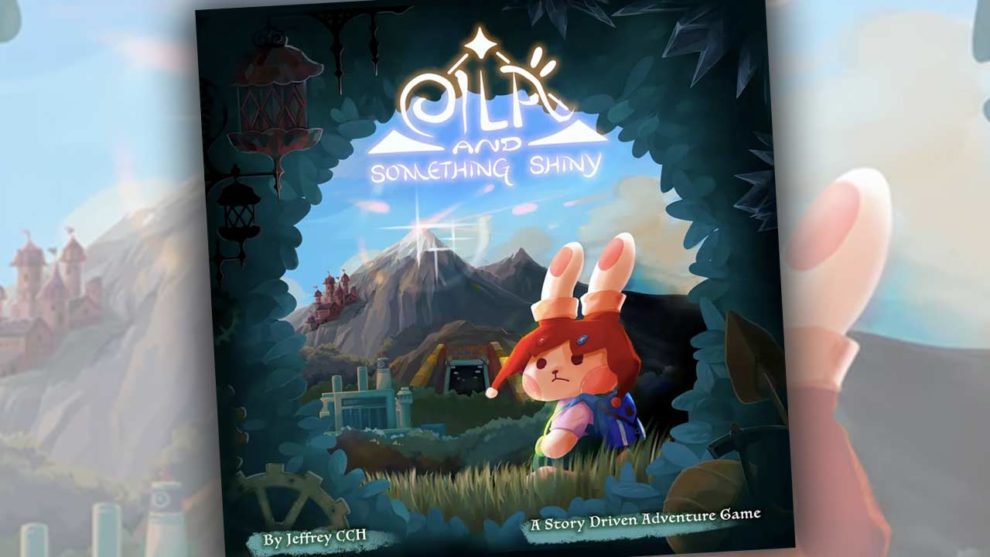The toughest thing about reviewing games like Eila and Something Shiny (NorthStar Game Studio) is not giving away parts of a story-driven campaign experience that are best discovered by the players.
So I will do my best to share what I liked most about my experience playing through all of the game’s chapters. (See? I didn’t even tell you how many chapters there are!!)
You’ve probably found this review because you searched for the game’s title; this is quite a niche marketing play by designer Jeffrey CCH and the team behind the game’s release. Most of the people I’ve spoken to think this game is called “Ella and…”, not Eily, as in, rhymes with Reilly.
The game could have just been called “Ella and the ____.” But Mr. CCH decided on Eila and Something Shiny, and that on its own makes the whole shebang a little more interesting.
I’m calling this out because the entire experience—like its title and the designer’s three-initial credited last name—is just a little different than you are expecting. The cover—and really, the entire game—has cutesy art courtesy of a host of illustrators led by Roxy Dai. But, the story is one that I’ll frame as “not always cutesy.”

Option A
Eila and Something Shiny can be played solo, or with a small group. (The box cover officially lists the player count as “1+.”) But when I considered playing this with my wife or with my entire four-person family, I decided against it when I read the rules. I thought the game would take too long with four people making decisions, instead of just me.
The box has secrets. The secrets make for a game that can be replayed by both the same set of players who finish the campaign the first time around, or another owner if the game is moved out of your collection. I am finding more and more campaign games that do this, and I love it. My recent play of Arkham Asylum: Panic in Gotham City allowed for a similar result, and in a world where games can be costly, moving them around via the secondhand market can help defray costs in a way that I’m loving more and more.
But more than anything else, I enjoyed my play of Eila and Something Shiny because the story was mostly told with visuals. From time to time, there is text—on event cards, on items that are acquired during the adventure, in booklets that accompany each chapter featuring a comic-book style format.

Plot Twist on Card ______
The majority of the story is told with images that really spark the imagination. Of course, I can’t tell you much about what appears on those cards, but images run the gamut in terms of the emotional spectrum. Some of the cards are beautiful, featuring images of characters that really made me think about the first time I saw, or experienced, or heard about, almost everything in my life.
Some of the cards are a bit upsetting; frightening is probably too strong of a word, but then again, I’m nearly 50 and I’ve seen some things over the years. Eila and Something Shiny doesn’t specifically call this out, but I wouldn’t call it a kids game because of some of the themes here. The game box says ages 12+; 16+ feels a little closer to the truth.
As someone who has friends who took their eight-year-old to see Barbie this summer, and knows another family who watched Die Hard with their 10-year-old for Christmas last year, it’s safe to assume that everyone has a different take on age-appropriate content.
The gameplay in Eila and Something Shiny is driven by cards that come from a chapter-specific deck. These cards have pictures, maybe a line of flavor text, then choices. Turn in this review by the scheduling deadline, maybe, for option A. Option B? Screw those scheduling deadlines, editorial team!! And then each choice really matters, maybe to the point of costing you the chapter.
That old Choose Your Own Adventure-style paperback, where you fall into a pit on page 77 because you forgot to light a torch on page 64? Eila and Something Shiny is a lot like those old books. I love that there are real choices to consider, and as a result, doing a second read of choices before committing to an action is often wise.

All of this helped tame my initial fears when taking on the game—was this going to turn into reading long sections of text every three minutes? Lots of the campaign games I play bog down when reading your 11th round of dense story paragraphs to advance the plot. In Eila and Something Shiny, you are always playing, as opposed to playing, talking, reading, playing, reading, playing.
I also liked that the included number of chapters felt like the right number of chapters without getting stale. I play video games all the time that are five-hour adventures spread across a 12-hour final product, because there’s so much filler, fetch-questing and dialogue choices in the way. Eila and Something Shiny says it is 30-45 minutes per chapter; that’s about right. That was enough game for me, and enough game to tell its story. (I had to replay a couple of chapters twice to beat them; at that length per chapter, I was comfortable going back and trying again.)
There’s a little game board used to display everything a player (or group) needs; an area for cards, some space for items that are discovered during the adventure, even a little backpack that Eila is wearing that holds her stuff. It’s tidy; even on my small kitchen table, I had plenty of space for everything.
As a result, set-up and teardown is a breeze. If anything, the hardest part was resetting cards for a future owner of the game; after I completed a chapter, I had to put a number of cards back in order for the next person in my network to discover the narrative. That might take just a few minutes for earlier chapters, more for the heavy stuff.
My list of negatives is brief. One of the chapters didn’t do a great job of detailing how it could end. That particular mission felt more like trial and error, instead of helping Eila discover XXXXXX through story-driven actions. It was also the longest of the chapters that I played. I had some minor issues with another mission, a character featured on the box, and understanding how to decipher clues in the way the game wanted me to.
Also (and this isn’t really a spoiler, given that Eila appears to be a rabbit): a man can only get so excited to collect carrots before looking for something else to do. Eila and Something Shiny does have a couple video game-style fetch quests in this way, and thankfully, you won’t have to do that much carrot collection.

Ending A, B, C
Eila and Something Shiny is certainly something: a dramatic adventure, a well-drawn production, a tidy solo game, and an experience unique in a tabletop industry that has by and large become what I’ll politely label “samey.” Gosh, I’m just happy in many cases to cover a game that attempts to take real risks, and Eila and Something Shiny certainly does that. (The game was originally released in 2021 by ICE Makes, which appears to be Mr. CCH’s publishing label.)
I was surprised how quickly I wanted to jump into each successive chapter. I binged all of the box contents over a mere two nights; I considered going back and trying the game again, just to discover some of the secrets I didn’t encounter in my first playthrough. And even though I ran through all of this quickly, the instructions encourage a style of play that allows for players to save their progress after each chapter on a small scoresheet, and doing that is really easy thanks to the excellent card and component organizer in the box.
Eila and Something Shiny is highly recommended…for adults. The themes will resonate more with those who have had a lifetime of experience to balance with the world Eila populates, and the nature of the game allows for a few chances to revisit how each chapter plays out. Even in a busy week, most players will finish the entire game in just a few nights, and I think their experience will be rich.
I hope that tabletop industry members who play Eila and Something Shiny will strive to build more backstory and theme into their experiences. Eila and Something Shiny feels like an olden-time adventure quest: get stuff, explore locations, discover…something. But this result? This is what happens when someone, or many people, try a lot harder. Give this game a look if you want to see what that success might look like.












Add Comment